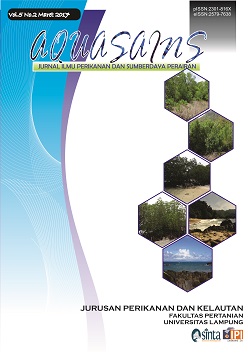STUDY OF SUITABILITY AND ENVIRONMENTAL CARRYING CAPACITY FOR BARRAMUNDI (Lates calcarifer. Bloch) CULTURE IN WATERS OF LEMUKUTAN ISLAND AND PENATA BESAR ISLAND, BENGKAYANG REGION, WEST KALIMANTAN
Abstract
The aim of this research are to study location suitability for developing Asian Seabass culture with floating cage culture system based on carrying capacity at Lemukutan Island and Penata Besar Island. The methods of this research include : field survey for assessing the biophysics characteristic of Lemukutan and Penata Besar Island, Geographycal Information System for suitability analyze and carrying capacity analyze which compare to Kepmen LH No. 51 Years 2004. The results indicated that all the water quality parameters mostly good and suitable to support Asian Seabass culture. GIS results indicated that 1.564 Ha can be developed for Asian Seabass culture on the floating net cage, or arround 14,44% from the total 10.830,7 Ha with depth about more than 6 metres and less than 25 metres. Limited factor are sheltered area from the wave, wind and storm, current rate are generally more than 0,6 m/s and depth water some less than 6 m and more than 25 m.
Downloads
Downloads
Published
How to Cite
Issue
Section
License
License for Authors
Authors who publish with this journal agree to the following terms:
- Authors retain copyright and grant the journal right of first publication with the work simultaneously licensed under a Creative Commons Attribution License that allows others to share the work with an acknowledgement of the work's authorship and initial publication in this journal.
- Authors are able to enter into separate, additional contractual arrangements for the non-exclusive distribution of the journal's published version of the work (e.g., post it to an institutional repository or publish it in a book), with an acknowledgement of its initial publication in this journal.
- When the article is accepted for publication, its copyright is transferred to Aquasains Journal. The copyright transfer convers the exclusive right to reproduce and distribute the article, including offprint, translation, photographic reproduction, microfilm, electronic material, (offline or online) or any other reproduction of similar nature.
- Authors are permitted and encouraged to post their work online (e.g., in institutional repositories or on their website) prior to and during the submission process, as it can lead to productive exchanges, as well as earlier and greater citation of published work (See The Effect of Open Access).
- The Author warrant that this article is original and that the author has full power to publish. The author sign for and accepts responsibility for releasing this material on behalf os any and all-author. If the article based on or part os student’s thesis, the student needs to sign as his/her agreement that his/her works is going published.
License for Regular Users
Other regular users who want to cite, distribute, remix, tweak, and build upon author’s works, even for commercial purposes, should acknowledge the work’s authorship and initial publication in this journal, licensed under a Creative Commons Attribution License.
This license lets others distribute, remix, tweak, and build upon your work, even commercially, as long as they credit you for the original creation.
This work is licensed under a Creative Commons Attribution 4.0 International License.Copyright Transfer Statement can be downloaded here


.png)









